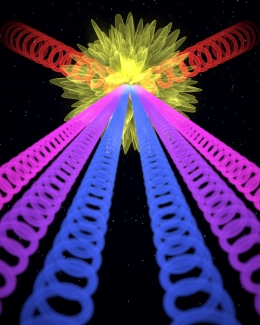The Kapteyn/Murnane group, with Visiting Fellow Charles Durfee, has figured out how to use visible lasers to control x-ray light! The new method not only preserves the beautiful coherence of laser light, but also makes an array of perfect x-ray laser beams with controlled direction and polarization. Such pulses may soon be used for observing chemical reactions or investigating the electronic motions inside atoms. They are also well suited for studying magnetic materials and chiral molecules like proteins or DNA that come in left- and right-handed versions.
This new discovery has taken tabletop femtosecond (10-15 s) and attosecond (10-18 s) x-ray bursts to a whole new level. The secret to the discovery: Research associate Dan Hickstein crossed two visible laser beams that were circularly polarized in opposite directions and sent them through a high-harmonic generation (HHG) process. The crossed laser beams entered a gas of argon where the laser field ripped electrons from the noble gas atoms. The laser field then changed direction, smashing the electrons back into their parent ions and producing an array of harmonics (soft x-ray beams of different wavelengths).
The new technique produced different color x-ray beams that emerged at distinct angles. As a result, it was straightforward to isolate and separate beams of different wavelengths and polarizations. And, with this capability came the power to tailor specific x-ray laser beams to individual experiments.
“All the left circularly polarized beams go in one direction, and all the right circularly polarized beams go in the other direction,” said Murnane. “This is quite amazing! Nobody thought you could have so much simultaneous control of the direction, polarization, and spectrum of light in the x-ray region.”
The researchers responsible for this breakthrough include Hickstein, former senior research associate Franklin Dollar, research associates Patrik Grychtol and Ronny Knut, former research associate Carlos Hernández-Garcia, graduate students Jennifer Ellis, Dmitriy Zusin, Christian Gentry, Tingting Fan, and Kevin Dorney, Justin Shaw (NIST), Visiting Fellow Charles Durfee (Colorado School of Mines), Associate Fellow Agnieszka Jaron-Becker, and Fellows Andreas Becker, Henry Kapteyn, and Margaret Murnane.
Visible lasers can now be used to precisely control x-rays, opening the door to investigating materials in ways that were never before possible. In fact, the technique is so new that no one yet knows its limits: The researchers don’t yet know how high in energy they can make the pulses; nor do they know how short a pulse they can generate or how bright it can be.
“The most dramatic advance here is that we now have the ability to steer x-ray light with visible lasers,” Murnane said. “To my knowledge, this is the first time anyone has figured out how to steer an x-ray beam with visible light. It’s really beautiful light science.”
The new method promises to be a boon to the use of x-ray laser beams in scientific experiments because good optics are not available to steer x-ray light. Those that are available are expensive, and they don’t work very well. Plus, it’s very difficult to design optics that preserve the very short bursts generated by HHG. In contrast, the new-found capability of manipulating x-ray light via the HHG generation process circumvents these disadvantages, making it easier to “see” what’s happening in experiments.
The nice thing about the new system is that researchers know what’s happening in real time, and, if needed, they can adjust the x-rays with a visible laser. So far, the researchers have used their new HHG x-ray beams to investigate magnetic materials. Their goal is to refine the new technique to create an x-ray spectrometer without using any x-ray optics. ––Julie Phillips




